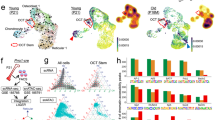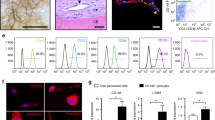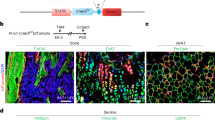Abstract
Pericytes are pluripotent cells that enclose the endothelium of small blood vessels in the whole body. These cells are thought to play a limited role in vascular development and blood pressure regulation; however, current evidence from numerous studies suggests several significant biologic aspects of pericytes in animals. One viewpoint is that pericytes are also known as potential cellular origin of multiple soft tissue tumors. Experimental evidence of the cellular origin of pericytic tumors is still insufficient, however, and their molecular pathogenesis is poorly understood. Here, we used a conditional constitutively active Smoothened allele (Rosa-SmoM2) and Cre recombinase mice to activate hedgehog (Hh) signaling, exclusively in the monocyte/macrophage and osteoclast lineage (LysMcre) or in RANK expressing cells (RANKcre) that are recognized as osteoclast precursor cells. Mice conditionally expressing SmoM2 with LysMcre displayed no significant skeletal phenotype; surprisingly, however, RANKcre; Rosa-SmoM2 mice frequently developed progressive soft tissue tumors in regions of the leg. Genetic lineage tracing analysis uncovered a new domain of RANKcre-expressing cells in the skeletal muscle interstitial cells that display markers consistent with vascular pericytes. Neoplasms arising from these cells showed increased expression of Matrix metalloproteinases (MMPs) that are molecular indicators of malignancy. Moreover, the tumors displayed strong bone invasive potency associated with osteoclastic bone resorption. Thus, these findings provide a novel insight into tumor pathology: Hh signal activated-pericytes can be a potential cellular origin of multiple soft tissue tumors.




Similar content being viewed by others
References
Antonescu CR, Agaram NP, Sung YS, Zhang L, Swanson D, Dickson BC (2018) A distinct malignant epithelioid neoplasm with GLI1 gene rearrangements, frequent S100 protein expression, and metastatic potential: expanding the spectrum of pathologic entities with ACTB/MALAT1/PTCH1-GLI1 fusions. Am J Surg Pathol 42:553–560
Armah HB, Parwani AV (2009) Perivascular epithelioid cell tumor. Arch Pathol Lab Med 133:648–654
Armulik A, Genove G, Betsholtz C (2011) Pericytes: developmental, physiological, and pathological perspectives, problems, and promises. Dev Cell 21:193–215
Cannonier SA, Gonzales CB, Ely K, Guelcher SA, Sterling JA (2016) Hedgehog and TGFbeta signaling converge on Gli2 to control bony invasion and bone destruction in oral squamous cell carcinoma. Oncotarget 7:76062–76075
Cannonier SA, Sterling JA (2015) The role of hedgehog signaling in tumor induced bone disease. Cancers (basel) 7:1658–1683
Caplan AI (2008) All MSCs are pericytes? Cell Stem Cell 3:229–230
Chang L, Zhao D, Liu HB, Wang QS, Zhang P, Li CL, Du WZ, Wang HJ, Liu X, Zhang ZR, Jiang CL (2015) Activation of sonic hedgehog signaling enhances cell migration and invasion by induction of matrix metalloproteinase-2 and -9 via the phosphoinositide-3 kinase/AKT signaling pathway in glioblastoma. Mol Med Rep 12:6702–6710
Clausen BE, Burkhardt C, Reith W, Renkawitz R, Forster I (1999) Conditional gene targeting in macrophages and granulocytes using LysMcre mice. Transgenic Res 8:265–277
Crisan M, Yap S, Casteilla L, Chen CW, Corselli M, Park TS, Andriolo G, Sun B, Zheng B, Zhang L, Norotte C, Teng PN, Traas J, Schugar R, Deasy BM, Badylak S, Buhring HJ, Giacobino JP, Lazzari L, Huard J, Peault B (2008) A perivascular origin for mesenchymal stem cells in multiple human organs. Cell Stem Cell 3:301–313
Dahlen A, Fletcher CD, Mertens F, Fletcher JA, Perez-Atayde AR, Hicks MJ, Debiec-Rychter M, Sciot R, Wejde J, Wedin R, Mandahl N, Panagopoulos I (2004) activation of the GLI oncogene through fusion with the beta-actin gene (ACTB) in a group of distinctive pericytic neoplasms: pericytoma with t(7;12). Am J Pathol 164:1645–1653
Das S, Samant RS, Shevde LA (2011) Hedgehog signaling induced by breast cancer cells promotes osteoclastogenesis and osteolysis. J Biol Chem 286:9612–9622
Das S, Samant RS, Shevde LA (2012) The hedgehog pathway conditions the bone microenvironment for osteolytic metastasis of breast cancer. Int J Breast Cancer 2012:298623
Dellavalle A, Sampaolesi M, Tonlorenzi R, Tagliafico E, Sacchetti B, Perani L, Innocenzi A, Galvez BG, Messina G, Morosetti R, Li S, Belicchi M, Peretti G, Chamberlain JS, Wright WE, Torrente Y, Ferrari S, Bianco P, Cossu G (2007) Pericytes of human skeletal muscle are myogenic precursors distinct from satellite cells. Nat Cell Biol 9:255–267
Drummond CJ, Hanna JA, Garcia MR, Devine DJ, Heyrana AJ, Finkelstein D, Rehg JE, Hatley ME (2018) Hedgehog pathway drives fusion-negative rhabdomyosarcoma initiated from non-myogenic endothelial progenitors. Cancer Cell 33:108–124 e105
Farrington-Rock C, Crofts NJ, Doherty MJ, Ashton BA, Griffin-Jones C, Canfield AE (2004) Chondrogenic and adipogenic potential of microvascular pericytes. Circulation 110:2226–2232
Feng X, Teitelbaum SL (2013) Osteoclasts: new insights. Bone Res 1:11–26
Folpe AL, Fanburg-Smith JC, Miettinen M, Weiss SW (2001) Atypical and malignant glomus tumors: analysis of 52 cases, with a proposal for the reclassification of glomus tumors. Am J Surg Pathol 25:1–12
Gailani MR, Stahle-Backdahl M, Leffell DJ, Glynn M, Zaphiropoulos PG, Pressman C, Unden AB, Dean M, Brash DE, Bale AE, Toftgard R (1996) The role of the human homologue of Drosophila patched in sporadic basal cell carcinomas. Nat Genet 14:78–81
Hahn H, Wojnowski L, Specht K, Kappler R, Calzada-Wack J, Potter D, Zimmer A, Muller U, Samson E, Quintanilla-Martinez L, Zimmer A (2000) Patched target Igf2 is indispensable for the formation of medulloblastoma and rhabdomyosarcoma. J Biol Chem 275:28341–28344
Haraguchi R, Kitazawa R, Mori K, Tachibana R, Kiyonari H, Imai Y, Abe T, Kitazawa S (2016) sFRP4-dependent Wnt signal modulation is critical for bone remodeling during postnatal development and age-related bone loss. Sci Rep 6:25198
Haraguchi R, Kitazawa R, Murashima A, Yamada G, Kitazawa S (2017) Developmental contribution of Wnt-signal-responsive cells to mouse reproductive tract formation. Acta Histochem Cytochem 50:127–133
Haraguchi R, Kohara Y, Matsubayashi K, Kitazawa R, Kitazawa S (2020) New insights into the pathogenesis of diabetic nephropathy: proximal renal tubules are primary target of oxidative stress in diabetic kidney. Acta Histochem Cytochem 53:21–31
Hatley ME, Tang W, Garcia MR, Finkelstein D, Millay DP, Liu N, Graff J, Galindo RL, Olson EN (2012) A mouse model of rhabdomyosarcoma originating from the adipocyte lineage. Cancer Cell 22:536–546
Honami T, Shimo T, Okui T, Kurio N, Hassan NM, Iwamoto M, Sasaki A (2012) Sonic hedgehog signaling promotes growth of oral squamous cell carcinoma cells associated with bone destruction. Oral Oncol 48:49–55
Jeng KS, Chang CF, Lin SS (2020) Sonic hedgehog signaling in organogenesis, tumors, and tumor microenvironments. Int J Mol Sci 21:758
Jeong J, Mao J, Tenzen T, Kottmann AH, McMahon AP (2004) Hedgehog signaling in the neural crest cells regulates the patterning and growth of facial primordia. Genes Dev 18:937–951
Kawakami R, Nakagami H, Noma T, Ohmori K, Kohno M, Morishita R (2016) RANKL system in vascular and valve calcification with aging. Inflamm Regen 36:10
Kobayashi N, Takahashi D, Takano S, Kimura S, Hase K (2019) The roles of Peyer’s patches and microfold cells in the gut immune system: relevance to autoimmune diseases. Front Immunol 10:2345
Kong JH, Siebold C, Rohatgi R (2019) Biochemical mechanisms of vertebrate hedgehog signaling. Development 146:dev166892
Kuo FY, Lin HC, Eng HL, Huang CC (2005) Sinonasal hemangiopericytoma-like tumor with true pericytic myoid differentiation: a clinicopathologic and immunohistochemical study of five cases. Head Neck 27:124–129
Lam CW, Xie J, To KF, Ng HK, Lee KC, Yuen NW, Lim PL, Chan LY, Tong SF, McCormick F (1999) A frequent activated smoothened mutation in sporadic basal cell carcinomas. Oncogene 18:833–836
Latroche C, Gitiaux C, Chretien F, Desguerre I, Mounier R, Chazaud B (2015) Skeletal muscle microvasculature: a highly dynamic lifeline. Physiology (Bethesda) 30:417–427
Lee Y, Kawagoe R, Sasai K, Li Y, Russell HR, Curran T, McKinnon PJ (2007) Loss of suppressor-of-fused function promotes tumorigenesis. Oncogene 26:6442–6447
Maeda K, Kobayashi Y, Udagawa N, Uehara S, Ishihara A, Mizoguchi T, Kikuchi Y, Takada I, Kato S, Kani S, Nishita M, Marumo K, Martin TJ, Minami Y, Takahashi N (2012) Wnt5a-Ror2 signaling between osteoblast-lineage cells and osteoclast precursors enhances osteoclastogenesis. Nat Med 18:405–412
Mao J, Ligon KL, Rakhlin EY, Thayer SP, Bronson RT, Rowitch D, McMahon AP (2006) A novel somatic mouse model to survey tumorigenic potential applied to the hedgehog pathway. Cancer Res 66:10171–10178
Mravic M, Asatrian G, Soo C, Lugassy C, Barnhill RL, Dry SM, Peault B, James AW (2014) From pericytes to perivascular tumours: correlation between pathology, stem cell biology, and tissue engineering. Int Orthop 38:1819–1824
Ney JT, Fehm T, Juhasz-Boess I, Solomayer EF (2012) RANK, RANKL and OPG expression in breast cancer - influence on osseous metastasis. Geburtshilfe Frauenheilkd 72:385–391
Ono T, Hayashi M, Sasaki F, Nakashima T (2020) RANKL biology: bone metabolism, the immune system, and beyond. Inflamm Regen 40:2
Raleigh DR, Reiter JF (2019) Misactivation of hedgehog signaling causes inherited and sporadic cancers. J Clin Invest 129:465–475
Rao S, Cronin SJF, Sigl V, Penninger JM (2018) RANKL and RANK: from mammalian physiology to cancer treatment. Trends Cell Biol 28:213–223
Raza A, Franklin MJ, Dudek AZ (2010) Pericytes and vessel maturation during tumor angiogenesis and metastasis. Am J Hematol 85:593–598
Ribeiro AL, Okamoto OK (2015) Combined effects of pericytes in the tumor microenvironment. Stem Cells Int 2015:868475
Sato K, Lee JW, Sakamoto K, Iimura T, Kayamori K, Yasuda H, Shindoh M, Ito M, Omura K, Yamaguchi A (2013) RANKL synthesized by both stromal cells and cancer cells plays a crucial role in osteoclastic bone resorption induced by oral cancer. Am J Pathol 182:1890–1899
Shimo T, Matsumoto K, Takabatake K, Aoyama E, Takebe Y, Ibaragi S, Okui T, Kurio N, Takada H, Obata K, Pang P, Iwamoto M, Nagatsuka H, Sasaki A (2016) The role of sonic hedgehog signaling in osteoclastogenesis and jaw bone destruction. PLoS One 11:e0151731
Stratman AN, Malotte KM, Mahan RD, Davis MJ, Davis GE (2009) Pericyte recruitment during vasculogenic tube assembly stimulates endothelial basement membrane matrix formation. Blood 114:5091–5101
Tamayo-Orrego L, Charron F (2019) Recent advances in SHH medulloblastoma progression: tumor suppressor mechanisms and the tumor microenvironment. F1000Res 8:F1000 Faculty Rev-1823
Theunissen JW, de Sauvage FJ (2009) Paracrine hedgehog signaling in cancer. Cancer Res 69:6007–6010
Tostar U, Malm CJ, Meis-Kindblom JM, Kindblom LG, Toftgard R, Unden AB (2006) Deregulation of the hedgehog signalling pathway: a possible role for the PTCH and SUFU genes in human rhabdomyoma and rhabdomyosarcoma development. J Pathol 208:17–25
Varjosalo M, Taipale J (2008) Hedgehog: functions and mechanisms. Genes Dev 22:2454–2472
Walsh MC, Choi Y (2021) Regulation of T cell-associated tissues and T cell activation by RANKL-RANK-OPG. J Bone Miner Metab 39:54–63
Wu X, Li F, Dang L, Liang C, Lu A, Zhang G (2020) RANKL/RANK system-based mechanism for breast cancer bone metastasis and related therapeutic strategies. Front Cell Dev Biol 8:76
Xie J, Murone M, Luoh SM, Ryan A, Gu Q, Zhang C, Bonifas JM, Lam CW, Hynes M, Goddard A, Rosenthal A, Epstein EH Jr, de Sauvage FJ (1998) Activating smoothened mutations in sporadic basal-cell carcinoma. Nature 391:90–92
Yamamoto M, Shook NA, Kanisicak O, Yamamoto S, Wosczyna MN, Camp JR, Goldhamer DJ (2009) A multifunctional reporter mouse line for Cre- and FLP-dependent lineage analysis. Genesis 47:107–114
Yasui R, Minatogawa T, Kanoh N, Nakata Y, Kubota A (2001) Nasal septal hemangiopericytoma-like tumor: a case report with an immunohistochemical study. Am J Rhinol 15:267–270
Zhang H, Wang Y, Chen T, Zhang Y, Xu R, Wang W, Cheng M, Chen Q (2019) Aberrant activation of hedgehog signalling promotes cell migration and invasion via matrix metalloproteinase -7 in ovarian cancer cells. J Cancer 10:990–1003
Zibat A, Missiaglia E, Rosenberger A, Pritchard-Jones K, Shipley J, Hahn H, Fulda S (2010) Activation of the hedgehog pathway confers a poor prognosis in embryonal and fusion gene-negative alveolar rhabdomyosarcoma. Oncogene 29:6323–6330
Acknowledgements
We thank Dr. Yasuhiro Kobayashi (Matsumoto Dental University) for RANKcre mice. The funders had no role in the study design, data collection and analysis, decision to publish, or preparation of the manuscript. We thank Y. Takaoka, M. Hashimoto, Y. Utsunomiya, K. Shimazu and A. Kondo for valuable assistance.
Funding
This work was supported in part by a Grant-in-Aid for Scientific Research from the Ministry of Education, Culture, Sports, Science and Technology, Japan (18K06832 to R.H. and 20H03458 to S. K.).
Author information
Authors and Affiliations
Contributions
R. H. designed the study, carried out most of the experiments, analyzed the data, supervised the project, and wrote the manuscript; R. H., R. K., Y. I., and S. K. contributed reagents/materials/analysis tools; Y. K. provided advice on the project; R. K. and S. K. provided financial support; all the authors reviewed the manuscript.
Corresponding author
Ethics declarations
Conflict of interest
The authors declare no competing interests.
Additional information
Publisher's Note
Springer Nature remains neutral with regard to jurisdictional claims in published maps and institutional affiliations.
Supplementary Information
Below is the link to the electronic supplementary material.
Rights and permissions
About this article
Cite this article
Haraguchi, R., Kitazawa, R., Kohara, Y. et al. Novel animal model of soft tissue tumor due to aberrant hedgehog signaling activation in pericyte lineage. Cell Tissue Res 388, 63–73 (2022). https://doi.org/10.1007/s00441-022-03578-0
Received:
Accepted:
Published:
Issue Date:
DOI: https://doi.org/10.1007/s00441-022-03578-0




